第七讲国际会计准则
- 格式:pptx
- 大小:913.64 KB
- 文档页数:57
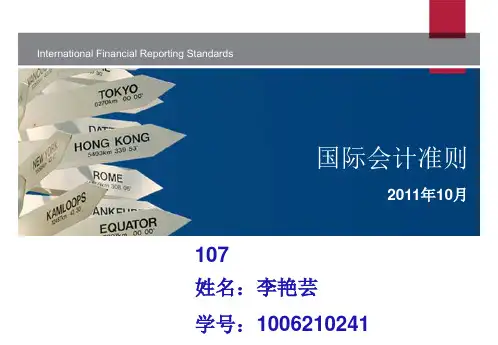


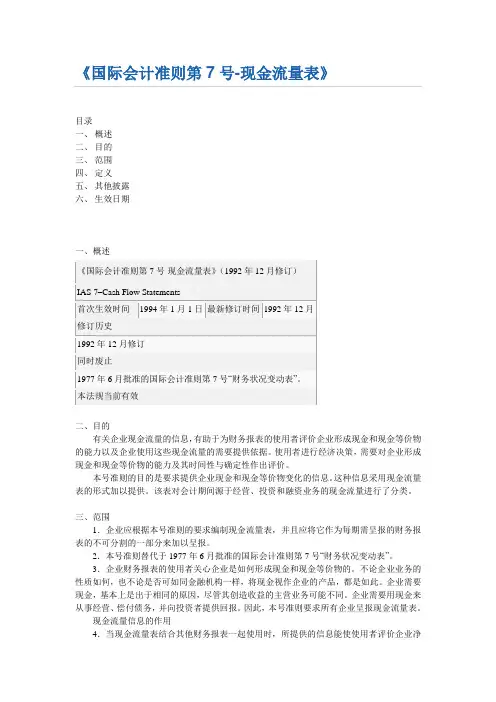
目录一、概述二、目的三、范围四、定义五、其他披露六、生效日期一、概述二、目的有关企业现金流量的信息,有助于为财务报表的使用者评价企业形成现金和现金等价物的能力以及企业使用这些现金流量的需要提供依据。
使用者进行经济决策,需要对企业形成现金和现金等价物的能力及其时间性与确定性作出评价。
本号准则的目的是要求提供企业现金和现金等价物变化的信息。
这种信息采用现金流量表的形式加以提供。
该表对会计期间源于经营、投资和融资业务的现金流量进行了分类。
三、范围1.企业应根据本号准则的要求编制现金流量表,并且应将它作为每期需呈报的财务报表的不可分割的一部分来加以呈报。
2.本号准则替代于1977年6月批准的国际会计准则第7号“财务状况变动表”。
3.企业财务报表的使用者关心企业是如何形成现金和现金等价物的。
不论企业业务的性质如何,也不论是否可如同金融机构一样,将现金视作企业的产品,都是如此。
企业需要现金,基本上是出于相同的原因,尽管其创造收益的主营业务可能不同。
企业需要用现金来从事经营、偿付债务,并向投资者提供回报。
因此,本号准则要求所有企业呈报现金流量表。
现金流量信息的作用4.当现金流量表结合其他财务报表一起使用时,所提供的信息能使使用者评价企业净资产的变动、财务结构(包括流动性和偿债能力),以及企业为适应环境和时机的变化而影响现金流量的金额和时间的能力。
现金流量的信息有助于评价企业形成现金和现金等价物的能力,并使使用者能够建立评价和比较不同企业未来现金流量的现值的模式。
它还提高了不同企业经营业绩报告的可比性,因为它消除了对相同交易和事项采用不同会计处理的影响。
5.关于以往现金流量的信息常用来作为未来现金流量的金额、时间和确定性的指标。
它还有助于复核过去对未来现金流量所作估计的准确性,以及检查获利能力、净现金流量与价格变动影响之间的关系。
四、定义6.本号准则所用的下列术语具有特定的含义:现金,包括库存现金和活期存款。
现金等价物,是指随时能转变为已知金额的现金的短期投资,其流动性高,价值变动的风险小。
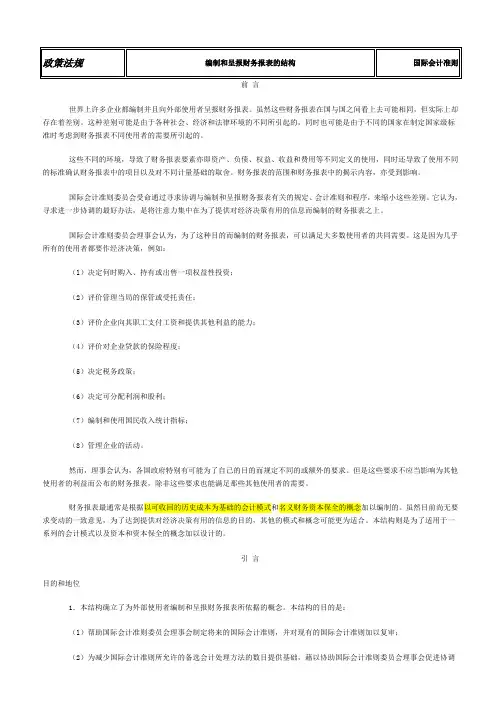
前言世界上许多企业都编制并且向外部使用者呈报财务报表。
虽然这些财务报表在国与国之间看上去可能相同,但实际上却存在着差别。
这种差别可能是由于各种社会、经济和法律环境的不同所引起的,同时也可能是由于不同的国家在制定国家级标准时考虑到财务报表不同使用者的需要所引起的。
这些不同的环境,导致了财务报表要素亦即资产、负债、权益、收益和费用等不同定义的使用,同时还导致了使用不同的标准确认财务报表中的项目以及对不同计量基础的取舍。
财务报表的范围和财务报表中的揭示内容,亦受到影响。
国际会计准则委员会受命通过寻求协调与编制和呈报财务报表有关的规定、会计准则和程序,来缩小这些差别。
它认为,寻求进一步协调的最好办法,是将注意力集中在为了提供对经济决策有用的信息而编制的财务报表之上。
国际会计准则委员会理事会认为,为了这种目的而编制的财务报表,可以满足大多数使用者的共同需要。
这是因为几乎所有的使用者都要作经济决策,例如:(l)决定何时购入、持有或出售一项权益性投资;(2)评价管理当局的保管或受托责任;(3)评价企业向其职工支付工资和提供其他利益的能力;(4)评价对企业贷款的保险程度;(5)决定税务政策;(6)决定可分配利润和股利;(7)编制和使用国民收入统计指标;(8)管理企业的活动。
然而,理事会认为,各国政府特别有可能为了自己的目的而规定不同的或额外的要求。
但是这些要求不应当影响为其他使用者的利益而公布的财务报表,除非这些要求也能满足那些其他使用者的需要。
财务报表最通常是根据以可收回的历史成本为基础的会计模式和名义财务资本保全的概念加以编制的。
虽然目前尚无要求变动的一致意见,为了达到提供对经济决策有用的信息的目的,其他的模式和概念可能更为适合。
本结构则是为了适用于一系列的会计模式以及资本和资本保全的概念加以设计的。
引言目的和地位1.本结构确立了为外部使用者编制和呈报财务报表所依据的概念。
本结构的目的是:(l)帮助国际会计准则委员会理事会制定将来的国际会计准则,并对现有的国际会计准则加以复审;(2)为减少国际会计准则所允许的备选会计处理方法的数目提供基础,藉以协助国际会计准则委员会理事会促进协调与编报财务报表有关的规定、会计准则和程序;(3)帮助国家级准则制定团体发展国家级准则;(4)帮助财务报表编制者应用国际会计准则和处理尚待列作国际会计准则题目的问题;(5)帮助审计师形成关于财务报表是否符合国际会计准则的意见;(6)帮助使用者理解按国际会计准则编制的财务报表中所包含的信息;(7)向关心国际会计准则委员会工作的人们提供关于制定国际会计准则的方法的资料。
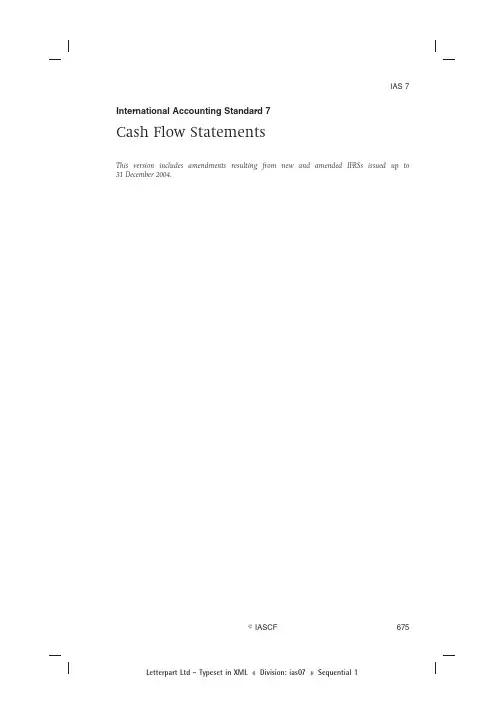
IAS7 International Accounting Standard7Cash Flow StatementsThis version includes amendments resulting from new and amended IFRSs issued up to 31December2004.IASCF675IAS7C ONTENTSparagraphs INTERNATIONAL ACCOUNTING STANDARD7CASH FLOW STATEMENTSOBJECTIVESCOPE1–3 BENEFITS OF CASH FLOW INFORMATION4–5 DEFINITIONS6–9 Cash and cash equivalents7–9 PRESENTATION OF A CASH FLOW STATEMENT10–17 Operating activities13–15 Investing activities16 Financing activities17 REPORTING CASH FLOWS FROM OPERATING ACTIVITIES18–20 REPORTING CASH FLOWS FROM INVESTING AND FINANCING ACTIVITIES21 REPORTING CASH FLOWS ON A NET BASIS22–24 FOREIGN CURRENCY CASH FLOWS25–28 INTEREST AND DIVIDENDS31–34 TAXES ON INCOME35–36 INVESTMENTS IN SUBSIDIARIES,ASSOCIATES AND JOINT VENTURES37–38 ACQUISITIONS AND DISPOSALS OF SUBSIDIARIES AND OTHER BUSINESSUNITS39–42 NON–CASH TRANSACTIONS43–44 COMPONENTS OF CASH AND CASH EQUIVALENTS45–47 OTHER DISCLOSURES48–52 EFFECTIVE DATE53 APPENDICESA Cash flow statement for an entity other than a financial institutionB Cash flow statement for a financial institution676IASCFIAS7 International Accounting Standard7Cash Flow Statements(IAS7)is set out in paragraphs1–53.All the paragraphs have equal authority but retain the IASC format of the Standard when it was adopted by the IASB.IAS7should be read in the context of its objective,the Preface to International Financial Reporting Standards and the Framework for the Preparation and Presentation of Financial Statements.IAS8Accounting Policies,Changes in Accounting Estimates and Errors provides a basis for selecting and applying accounting policies in the absence of explicit guidance.IASCF677IAS7International Accounting Standard7Cash Flow StatementsObjectiveInformation about the cash flows of an entity is useful in providing users offinancial statements with a basis to assess the ability of the entity to generate cashand cash equivalents and the needs of the entity to utilise those cash flows.The economic decisions that are taken by users require an evaluation of the abilityof an entity to generate cash and cash equivalents and the timing and certainty oftheir generation.The objective of this Standard is to require the provision of information about thehistorical changes in cash and cash equivalents of an entity by means of a cashflow statement which classifies cash flows during the period from operating,investing and financing activities.Scope1An entity shall prepare a cash flow statement in accordance with the requirements of this Standard and shall present it as an integral part of itsfinancial statements for each period for which financial statements arepresented.2This Standard supersedes IAS7Statement of Changes in Financial Position,approved in July1977.3Users of an entity’s financial statements are interested in how the entity generates and uses cash and cash equivalents.This is the case regardless of the nature of theentity’s activities and irrespective of whether cash can be viewed as the product ofthe entity,as may be the case with a financial institution.Entities need cash foressentially the same reasons however different their principal revenue-producingactivities might be.They need cash to conduct their operations,to pay theirobligations,and to provide returns to their investors.Accordingly,this Standardrequires all entities to present a cash flow statement.Benefits of cash flow information4A cash flow statement,when used in conjunction with the rest of the financial statements,provides information that enables users to evaluate the changes in netassets of an entity,its financial structure(including its liquidity and solvency)andits ability to affect the amounts and timing of cash flows in order to adapt tochanging circumstances and opportunities.Cash flow information is useful inassessing the ability of the entity to generate cash and cash equivalents andenables users to develop models to assess and compare the present value of thefuture cash flows of different entities.It also enhances the comparability of thereporting of operating performance by different entities because it eliminates theeffects of using different accounting treatments for the same transactions andevents.678IASCFIAS75Historical cash flow information is often used as an indicator of the amount, timing and certainty of future cash flows.It is also useful in checking theaccuracy of past assessments of future cash flows and in examining therelationship between profitability and net cash flow and the impact of changingprices.Definitions6The following terms are used in this Standard with the meanings specified: Cash comprises cash on hand and demand deposits.Cash equivalents are short-term,highly liquid investments that are readilyconvertible to known amounts of cash and which are subject to aninsignificant risk of changes in value.Cash flows are inflows and outflows of cash and cash equivalents.Operating activities are the principal revenue-producing activities of the entityand other activities that are not investing or financing activities.Investing activities are the acquisition and disposal of long-term assets andother investments not included in cash equivalents.Financing activities are activities that result in changes in the size andcomposition of the contributed equity and borrowings of the entity.Cash and cash equivalents7Cash equivalents are held for the purpose of meeting short-term cash commitments rather than for investment or other purposes.For an investment toqualify as a cash equivalent it must be readily convertible to a known amount ofcash and be subject to an insignificant risk of changes in value.Therefore,aninvestment normally qualifies as a cash equivalent only when it has a shortmaturity of,say,three months or less from the date of acquisition.Equityinvestments are excluded from cash equivalents unless they are,in substance,cash equivalents,for example in the case of preferred shares acquired within ashort period of their maturity and with a specified redemption date.8Bank borrowings are generally considered to be financing activities.However,in some countries,bank overdrafts which are repayable on demand form an integralpart of an entity’s cash management.In these circumstances,bank overdrafts areincluded as a component of cash and cash equivalents.A characteristic of suchbanking arrangements is that the bank balance often fluctuates from beingpositive to overdrawn.9Cash flows exclude movements between items that constitute cash or cash equivalents because these components are part of the cash management of anentity rather than part of its operating,investing and financing activities.Cash management includes the investment of excess cash in cash equivalents.Presentation of a cash flow statement10The cash flow statement shall report cash flows during the period classified by operating,investing and financing activities.IASCF679IAS711An entity presents its cash flows from operating,investing and financing activities in a manner which is most appropriate to its business.Classification by activityprovides information that allows users to assess the impact of those activities onthe financial position of the entity and the amount of its cash and cashequivalents.This information may also be used to evaluate the relationshipsamong those activities.12A single transaction may include cash flows that are classified differently.For example,when the cash repayment of a loan includes both interest andcapital,the interest element may be classified as an operating activity and thecapital element is classified as a financing activity.Operating activities13The amount of cash flows arising from operating activities is a key indicator of the extent to which the operations of the entity have generated sufficient cash flowsto repay loans,maintain the operating capability of the entity,pay dividends andmake new investments without recourse to external sources of financing.Information about the specific components of historical operating cash flows isuseful,in conjunction with other information,in forecasting future operatingcash flows.14Cash flows from operating activities are primarily derived from the principal revenue-producing activities of the entity.Therefore,they generally result fromthe transactions and other events that enter into the determination of profit orloss.Examples of cash flows from operating activities are:(a)cash receipts from the sale of goods and the rendering of services;(b)cash receipts from royalties,fees,commissions and other revenue;(c)cash payments to suppliers for goods and services;(d)cash payments to and on behalf of employees;(e)cash receipts and cash payments of an insurance entity for premiums andclaims,annuities and other policy benefits;(f)cash payments or refunds of income taxes unless they can be specificallyidentified with financing and investing activities;and(g)cash receipts and payments from contracts held for dealing or tradingpurposes.Some transactions,such as the sale of an item of plant,may give rise to a gain orloss which is included in the determination of profit or loss.However,the cashflows relating to such transactions are cash flows from investing activities.15An entity may hold securities and loans for dealing or trading purposes,in which case they are similar to inventory acquired specifically for resale.Therefore,cashflows arising from the purchase and sale of dealing or trading securities areclassified as operating activities.Similarly,cash advances and loans made byfinancial institutions are usually classified as operating activities since they relateto the main revenue-producing activity of that entity.680IASCFIAS7Investing activities16The separate disclosure of cash flows arising from investing activities is important because the cash flows represent the extent to which expenditures have beenmade for resources intended to generate future income and cash flows.Examplesof cash flows arising from investing activities are:(a)cash payments to acquire property,plant and equipment,intangibles andother long-term assets.These payments include those relating to capitaliseddevelopment costs and self-constructed property,plant and equipment;(b)cash receipts from sales of property,plant and equipment,intangibles andother long-term assets;(c)cash payments to acquire equity or debt instruments of other entities andinterests in joint ventures(other than payments for those instrumentsconsidered to be cash equivalents or those held for dealing or tradingpurposes);(d)cash receipts from sales of equity or debt instruments of other entities andinterests in joint ventures(other than receipts for those instrumentsconsidered to be cash equivalents and those held for dealing or tradingpurposes);(e)cash advances and loans made to other parties(other than advances andloans made by a financial institution);(f)cash receipts from the repayment of advances and loans made to otherparties(other than advances and loans of a financial institution);(g)cash payments for futures contracts,forward contracts,option contracts andswap contracts except when the contracts are held for dealing or tradingpurposes,or the payments are classified as financing activities;and(h)cash receipts from futures contracts,forward contracts,option contracts andswap contracts except when the contracts are held for dealing or tradingpurposes,or the receipts are classified as financing activities.When a contract is accounted for as a hedge of an identifiable position,the cashflows of the contract are classified in the same manner as the cash flows of theposition being hedged.Financing activities17The separate disclosure of cash flows arising from financing activities is important because it is useful in predicting claims on future cash flows by providers ofcapital to the entity.Examples of cash flows arising from financing activities are:(a)cash proceeds from issuing shares or other equity instruments;(b)cash payments to owners to acquire or redeem the entity’s shares;(c)cash proceeds from issuing debentures,loans,notes,bonds,mortgages andother short or long-term borrowings;(d)cash repayments of amounts borrowed;and(e)cash payments by a lessee for the reduction of the outstanding liabilityrelating to a finance lease.IASCF681IAS7Reporting cash flows from operating activities18An entity shall report cash flows from operating activities using either:(a)the direct method,whereby major classes of gross cash receipts andgross cash payments are disclosed;or(b)the indirect method,whereby profit or loss is adjusted for the effectsof transactions of a non-cash nature,any deferrals or accruals of pastor future operating cash receipts or payments,and items of income orexpense associated with investing or financing cash flows.19Entities are encouraged to report cash flows from operating activities using the direct method.The direct method provides information which may be useful inestimating future cash flows and which is not available under the indirectmethod.Under the direct method,information about major classes of gross cashreceipts and gross cash payments may be obtained either:(a)from the accounting records of the entity;or(b)by adjusting sales,cost of sales(interest and similar income and interestexpense and similar charges for a financial institution)and other items inthe income statement for:(i)changes during the period in inventories and operating receivables andpayables;(ii)other non-cash items;and(iii)other items for which the cash effects are investing or financing cash flows.20Under the indirect method,the net cash flow from operating activities is determined by adjusting profit or loss for the effects of:(a)changes during the period in inventories and operating receivables andpayables;(b)non-cash items such as depreciation,provisions,deferred taxes,unrealisedforeign currency gains and losses,undistributed profits of associates,andminority interests;and(c)all other items for which the cash effects are investing or financing cashflows.Alternatively,the net cash flow from operating activities may be presented underthe indirect method by showing the revenues and expenses disclosed in theincome statement and the changes during the period in inventories and operatingreceivables and payables.Reporting cash flows from investing and financing activities21An entity shall report separately major classes of gross cash receipts and gross cash payments arising from investing and financing activities,exceptto the extent that cash flows described in paragraphs22and24arereported on a net basis.682IASCFIAS7 Reporting cash flows on a net basis22Cash flows arising from the following operating,investing or financing activities may be reported on a net basis:(a)cash receipts and payments on behalf of customers when the cashflows reflect the activities of the customer rather than those of theentity;and(b)cash receipts and payments for items in which the turnover is quick,the amounts are large,and the maturities are short.23Examples of cash receipts and payments referred to in paragraph22(a)are:(a)the acceptance and repayment of demand deposits of a bank;(b)funds held for customers by an investment entity;and(c)rents collected on behalf of,and paid over to,the owners of properties.Examples of cash receipts and payments referred to in paragraph22(b)areadvances made for,and the repayment of:(a)principal amounts relating to credit card customers;(b)the purchase and sale of investments;and(c)other short-term borrowings,for example,those which have a maturityperiod of three months or less.24Cash flows arising from each of the following activities of a financial institution may be reported on a net basis:(a)cash receipts and payments for the acceptance and repayment ofdeposits with a fixed maturity date;(b)the placement of deposits with and withdrawal of deposits from otherfinancial institutions;and(c)cash advances and loans made to customers and the repayment ofthose advances and loans.Foreign currency cash flows25Cash flows arising from transactions in a foreign currency shall be recorded in an entity’s functional currency by applying to the foreigncurrency amount the exchange rate between the functional currency andthe foreign currency at the date of the cash flow.26The cash flows of a foreign subsidiary shall be translated at the exchange rates between the functional currency and the foreign currency at the datesof the cash flows.27Cash flows denominated in a foreign currency are reported in a manner consistent with IAS21Accounting for the Effects of Changes in Foreign Exchange Rates.This permits the use of an exchange rate that approximates the actual rate.For example,a weighted average exchange rate for a period may be used forrecording foreign currency transactions or the translation of the cash flows of aIASCF683IAS7foreign subsidiary.However,IAS21does not permit use of the exchange rate atthe balance sheet date when translating the cash flows of a foreign subsidiary.28Unrealised gains and losses arising from changes in foreign currency exchange rates are not cash flows.However,the effect of exchange rate changes on cash andcash equivalents held or due in a foreign currency is reported in the cash flowstatement in order to reconcile cash and cash equivalents at the beginning andthe end of the period.This amount is presented separately from cash flows fromoperating,investing and financing activities and includes the differences,if any,had those cash flows been reported at end of period exchange rates.29[Deleted]30[Deleted]Interest and dividends31Cash flows from interest and dividends received and paid shall each be disclosed separately.Each shall be classified in a consistent manner fromperiod to period as either operating,investing or financing activities.32The total amount of interest paid during a period is disclosed in the cash flow statement whether it has been recognised as an expense in the income statementor capitalised in accordance with the allowed alternative treatment in IAS23Borrowing Costs.33Interest paid and interest and dividends received are usually classified as operating cash flows for a financial institution.However,there is no consensus onthe classification of these cash flows for other entities.Interest paid and interestand dividends received may be classified as operating cash flows because theyenter into the determination of profit or loss.Alternatively,interest paid andinterest and dividends received may be classified as financing cash flows andinvesting cash flows respectively,because they are costs of obtaining financialresources or returns on investments.34Dividends paid may be classified as a financing cash flow because they are a cost of obtaining financial resources.Alternatively,dividends paid may be classified as acomponent of cash flows from operating activities in order to assist users todetermine the ability of an entity to pay dividends out of operating cash flows. Taxes on income35Cash flows arising from taxes on income shall be separately disclosed and shall be classified as cash flows from operating activities unless they can bespecifically identified with financing and investing activities.36Taxes on income arise on transactions that give rise to cash flows that are classified as operating,investing or financing activities in a cash flow statement.While tax expense may be readily identifiable with investing or financingactivities,the related tax cash flows are often impracticable to identify and mayarise in a different period from the cash flows of the underlying transaction.Therefore,taxes paid are usually classified as cash flows from operating activities.However,when it is practicable to identify the tax cash flow with an individualtransaction that gives rise to cash flows that are classified as investing or 684IASCFIAS7financing activities the tax cash flow is classified as an investing or financingactivity as appropriate.When tax cash flows are allocated over more than oneclass of activity,the total amount of taxes paid is disclosed.Investments in subsidiaries,associates and joint ventures37When accounting for an investment in an associate or a subsidiary accounted for by use of the equity or cost method,an investor restricts its reporting in the cashflow statement to the cash flows between itself and the investee,for example,todividends and advances.38An entity which reports its interest in a jointly controlled entity(see IAS31 Interests in Joint Ventures)using proportionate consolidation,includes in itsconsolidated cash flow statement its proportionate share of the jointly controlledentity’s cash flows.An entity which reports such an interest using the equitymethod includes in its cash flow statement the cash flows in respect of itsinvestments in the jointly controlled entity,and distributions and other paymentsor receipts between it and the jointly controlled entity.Acquisitions and disposals of subsidiaries and other business units39The aggregate cash flows arising from acquisitions and from disposals of subsidiaries or other business units shall be presented separately andclassified as investing activities.40An entity shall disclose,in aggregate,in respect of both acquisitions and disposals of subsidiaries or other business units during the period each ofthe following:(a)the total purchase or disposal consideration;(b)the portion of the purchase or disposal consideration discharged bymeans of cash and cash equivalents;(c)the amount of cash and cash equivalents in the subsidiary or businessunit acquired or disposed of;and(d)the amount of the assets and liabilities other than cash or cashequivalents in the subsidiary or business unit acquired or disposed of,summarised by each major category.41The separate presentation of the cash flow effects of acquisitions and disposals of subsidiaries and other business units as single line items,together with theseparate disclosure of the amounts of assets and liabilities acquired or disposed of,helps to distinguish those cash flows from the cash flows arising from the otheroperating,investing and financing activities.The cash flow effects of disposals arenot deducted from those of acquisitions.42The aggregate amount of the cash paid or received as purchase or sale consideration is reported in the cash flow statement net of cash and cashequivalents acquired or disposed of.IASCF685IAS7Non–cash transactions43Investing and financing transactions that do not require the use of cash or cash equivalents shall be excluded from a cash flow statement.Suchtransactions shall be disclosed elsewhere in the financial statements in away that provides all the relevant information about these investing andfinancing activities.44Many investing and financing activities do not have a direct impact on current cash flows although they do affect the capital and asset structure of an entity.The exclusion of non-cash transactions from the cash flow statement is consistentwith the objective of a cash flow statement as these items do not involve cashflows in the current period.Examples of non-cash transactions are:(a)the acquisition of assets either by assuming directly related liabilities or bymeans of a finance lease;(b)the acquisition of an entity by means of an equity issue;and(c)the conversion of debt to equity.Components of cash and cash equivalents45An entity shall disclose the components of cash and cash equivalents and shall present a reconciliation of the amounts in its cash flow statementwith the equivalent items reported in the balance sheet.46In view of the variety of cash management practices and banking arrangements around the world and in order to comply with IAS1Presentation of FinancialStatements,an entity discloses the policy which it adopts in determining thecomposition of cash and cash equivalents.47The effect of any change in the policy for determining components of cash and cash equivalents,for example,a change in the classification of financialinstruments previously considered to be part of an entity’s investment portfolio,isreported in accordance with IAS8Accounting Policies,Changes in Accounting Estimatesand Errors.Other disclosures48An entity shall disclose,together with a commentary by management,the amount of significant cash and cash equivalent balances held by the entitythat are not available for use by the group.49There are various circumstances in which cash and cash equivalent balances held by an entity are not available for use by the group.Examples include cash andcash equivalent balances held by a subsidiary that operates in a country whereexchange controls or other legal restrictions apply when the balances are notavailable for general use by the parent or other subsidiaries.50Additional information may be relevant to users in understanding the financial position and liquidity of an entity.Disclosure of this information,together with acommentary by management,is encouraged and may include:686IASCFIAS7(a)the amount of undrawn borrowing facilities that may be available for futureoperating activities and to settle capital commitments,indicating anyrestrictions on the use of these facilities;(b)the aggregate amounts of the cash flows from each of operating,investingand financing activities related to interests in joint ventures reported usingproportionate consolidation;(c)the aggregate amount of cash flows that represent increases in operatingcapacity separately from those cash flows that are required to maintainoperating capacity;and(d)the amount of the cash flows arising from the operating,investing andfinancing activities of each reported industry and geographical segment(see IAS14Segment Reporting).51The separate disclosure of cash flows that represent increases in operating capacity and cash flows that are required to maintain operating capacity is usefulin enabling the user to determine whether the entity is investing adequately inthe maintenance of its operating capacity.An entity that does not investadequately in the maintenance of its operating capacity may be prejudicing futureprofitability for the sake of current liquidity and distributions to owners.52The disclosure of segmental cash flows enables users to obtain a better understanding of the relationship between the cash flows of the business as awhole and those of its component parts and the availability and variability ofsegmental cash flows.Effective date53This Standard becomes operative for financial statements covering periods beginning on or after1January1994.IASCF687。
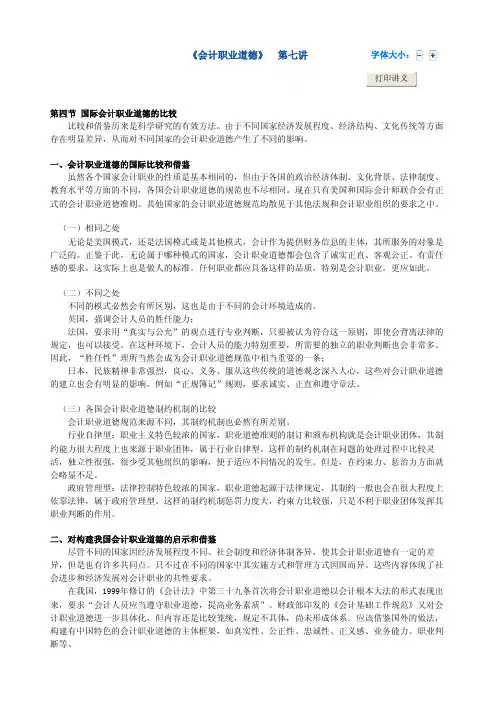
《会计职业道德》 第七讲 字体大小:打印讲义第四节 国际会计职业道德的比较比较和借鉴历来是科学研究的有效方法。
由于不同国家经济发展程度、经济结构、文化传统等方面存在明显差异,从而对不同国家的会计职业道德产生了不同的影响。
一、会计职业道德的国际比较和借鉴虽然各个国家会计职业的性质是基本相同的,但由于各国的政治经济体制、文化背景、法律制度、教育水平等方面的不同,各国会计职业道德的规范也不尽相同。
现在只有美国和国际会计师联合会有正式的会计职业道德准则。
其他国家的会计职业道德规范均散见于其他法规和会计职业组织的要求之中。
(一)相同之处无论是美国模式,还是法国模式或是其他模式,会计作为提供财务信息的主体,其所服务的对象是广泛的。
正鉴于此,无论属于哪种模式的国家,会计职业道德都会包含了诚实正直、客观公正、有责任感的要求。
这实际上也是做人的标准。
任何职业都应具备这样的品质,特别是会计职业,更应如此。
(二)不同之处不同的模式必然会有所区别,这也是由于不同的会计环境造成的。
英国,强调会计人员的胜任能力;法国,要求用“真实与公允”的观点进行专业判断,只要被认为符合这一原则,即使会背离法律的规定,也可以接受。
在这种环境下,会计人员的能力特别重要,所需要的独立的职业判断也会非常多。
因此,“胜任性”理所当然会成为会计职业道德规范中相当重要的一条;日本,民族精神非常强烈,良心、义务、服从这些传统的道德观念深入人心,这些对会计职业道德的建立也会有明显的影响。
例如“正规簿记”规则,要求诚实、正直和遵守章法。
(三)各国会计职业道德制约机制的比较会计职业道德规范来源不同,其制约机制也必然有所差别。
行业自律型:职业主义特色较浓的国家,职业道德准则的制订和颁布机构就是会计职业团体,其制约能力很大程度上也来源于职业团体,属于行业自律型。
这样的制约机制在问题的处理过程中比较灵活,独立性很强,很少受其他组织的影响,便于适应不同情况的发生。
但是,在约束力、惩治力方面就会略显不足。


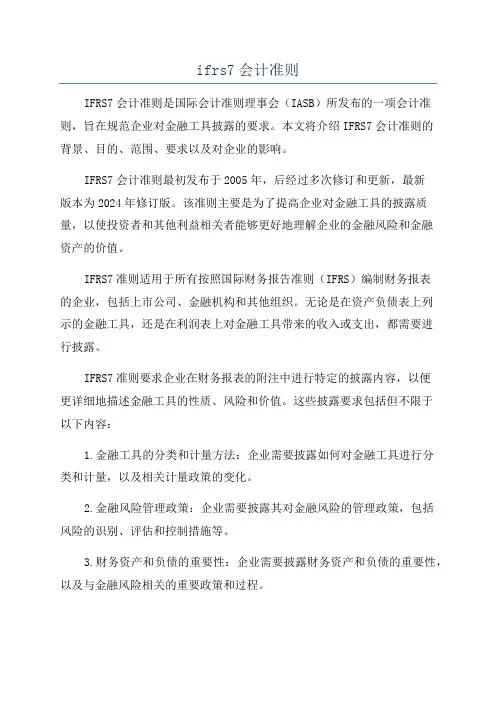
ifrs7会计准则IFRS7会计准则是国际会计准则理事会(IASB)所发布的一项会计准则,旨在规范企业对金融工具披露的要求。
本文将介绍IFRS7会计准则的背景、目的、范围、要求以及对企业的影响。
IFRS7会计准则最初发布于2005年,后经过多次修订和更新,最新版本为2024年修订版。
该准则主要是为了提高企业对金融工具的披露质量,以使投资者和其他利益相关者能够更好地理解企业的金融风险和金融资产的价值。
IFRS7准则适用于所有按照国际财务报告准则(IFRS)编制财务报表的企业,包括上市公司、金融机构和其他组织。
无论是在资产负债表上列示的金融工具,还是在利润表上对金融工具带来的收入或支出,都需要进行披露。
IFRS7准则要求企业在财务报表的附注中进行特定的披露内容,以便更详细地描述金融工具的性质、风险和价值。
这些披露要求包括但不限于以下内容:1.金融工具的分类和计量方法:企业需要披露如何对金融工具进行分类和计量,以及相关计量政策的变化。
2.金融风险管理政策:企业需要披露其对金融风险的管理政策,包括风险的识别、评估和控制措施等。
3.财务资产和负债的重要性:企业需要披露财务资产和负债的重要性,以及与金融风险相关的重要政策和过程。
4.金融衍生工具:企业需要披露其使用的金融衍生工具的资金量、风险敞口以及与金融衍生工具相关的政策和流程。
5.资产负债表和利润表披露:企业需要披露金融工具在资产负债表上的分类和计量,以及在利润表上产生的收入、费用和损益。
IFRS7准则对企业的影响是显著的。
首先,它增加了企业对金融工具相关信息的披露要求,提高了财务报表的透明度和可比性,使投资者和其他利益相关者能够更好地理解企业的财务状况和风险。
其次,IFRS7准则也促使企业加强对金融工具的风险管理和内部控制。
企业需要识别、评估和控制金融风险,并披露其管理政策和过程。
这有助于提高企业的风险管理能力,保护利益相关者的利益。
此外,IFRS7准则还推动了企业对金融工具披露实践的不断改进。
![国际会计准则第7号-现金流量表[1]剖析.](https://uimg.taocdn.com/041fb20ab5daa58da0116c175f0e7cd184251833.webp)
国际会计准则第7号-现金流量表[1]剖析.国际会计准则第7号--现金流量表国际会计准则第7号(1992年12月修订)目的有关企业现金流量的信息,有助于为财务报表的使用者评价企业形成现金和现金等价物的能力以及企业使用这些现金流量的需要提供依据。
使用者进行经济决策,需要对企业形成现金和现金等价物的能力及其时间性与确定性作出评价。
本号准则的目的是要求提供企业现金和现金等价物变化的信息。
这种信息采用现金流量表的形式加以提供。
该表对会计期间源于经营、投资和融资业务的现金流量进行了分类。
范围1.企业应根据本号准则的要求编制现金流量表,并且应将它作为每期需呈报的财务报表的不可分割的一部分来加以呈报。
2.本号准则替代于1977年6月批准的国际会计准则第7号财务状况变动表.3.企业财务报表的使用者关心企业是如何形成现金和现金等价物的。
不论企业业务的性质如何,也不论是否可如同金融机构一样,将现金视作企业的产品,都是如此。
企业需要现金,基本上是出于相同的原因,尽管其创造收益的主营业务可能不同。
企业需要用现金来从事经营、偿付债务,并向投资者提供回报。
因此,本号准则要求所有企业呈报现金流量表。
现金流量信息的作用4.当现金流量表结合其他财务报表一起使用时,所提供的信息能使使用者评价企业净资产的变动、财务结构(包括流动性和偿债能力),以及企业为适应环境和时机的变化而影响现金流量的金额和时间的能力。
现金流量的信息有助于评价企业形成现金和现金等价物的能力,并使使用者能够建立评价和比较不同企业未来现金流量的现值的模式。
它还提高了不同企业经营业绩报告的可比性,因为它消除了对相同交易和事项采用不同会计处理的影响。
5.关于以往现金流量的信息常用来作为未来现金流量的金额、时间和确定性的指标。
它还有助于复核过去对未来现金流量所作估计的准确性,以及检查获利能力、净现金流量与价格变动影响之间的关系。
定义6.本号准则所用的下列术语具有特定的含义:现金,包括库存现金和活期存款。
最新国际会计准则ias7————————————————————————————————作者:————————————————————————————————日期:2《国际会计准则第7号-现金流量表》目录一、概述二、目的三、范围四、定义五、其他披露六、生效日期一、概述《国际会计准则第7号-现金流量表》(1992年12月修订)IAS 7–Cash Flow Statements首次生效时间1994年1月1日最新修订时间1992年12月修订历史1992年12月修订同时废止1977年6月批准的国际会计准则第7号“财务状况变动表”。
本法规当前有效二、目的有关企业现金流量的信息,有助于为财务报表的使用者评价企业形成现金和现金等价物的能力以及企业使用这些现金流量的需要提供依据。
使用者进行经济决策,需要对企业形成现金和现金等价物的能力及其时间性与确定性作出评价。
本号准则的目的是要求提供企业现金和现金等价物变化的信息。
这种信息采用现金流量表的形式加以提供。
该表对会计期间源于经营、投资和融资业务的现金流量进行了分类。
三、范围1.企业应根据本号准则的要求编制现金流量表,并且应将它作为每期需呈报的财务报表的不可分割的一部分来加以呈报。
2.本号准则替代于1977年6月批准的国际会计准则第7号“财务状况变动表”。
3.企业财务报表的使用者关心企业是如何形成现金和现金等价物的。
不论企业业务的性质如何,也不论是否可如同金融机构一样,将现金视作企业的产品,都是如此。
企业需要现金,基本上是出于相同的原因,尽管其创造收益的主营业务可能不同。
企业需要用现金来从事经营、偿付债务,并向投资者提供回报。
因此,本号准则要求所有企业呈报现金流量表。
现金流量信息的作用4.当现金流量表结合其他财务报表一起使用时,所提供的信息能使使用者评价企业净资产的变动、财务结构(包括流动性和偿债能力),以及企业为适应环境和时机的变化而影响现金流量的金额和时间的能力。
国际会计准则1. 概述国际会计准则(International Financial Reporting Standards,简称IFRS),是由国际会计准则委员会(International Accounting Standards Board,简称IASB)制定的一套全球通用的会计准则。
IFRS的目标是提供一套全球统一、可比较的财务报告准则,以提高财务报告的透明度和一致性。
2. IFRS的背景与发展国际会计准则起源于20世纪70年代,当时不同国家会计准则之间的差异给国际投资和跨国交易带来了很多困扰。
为了解决这个问题,国际会计准则委员会于2001年成立,开始制定统一的国际会计准则。
自那时以来,IFRS已经成为国际金融市场上使用最广泛的会计准则。
3. IFRS的特点IFRS的特点有以下几个方面:3.1 全球通用性IFRS被广泛接受和采用,超过150个国家和地区已经采用了IFRS作为其财务报告准则。
这使得不同国家和地区的企业能够使用同一套会计准则来编制财务报告,减少了跨国交易和国际投资的风险。
3.2 可比性IFRS提供了一套统一的会计准则,可以使不同企业的财务报告变得可比较。
这对于国际投资者和分析师来说非常重要,因为他们需要通过比较不同企业的财务报告来做出投资决策。
3.3 透明度IFRS要求企业提供详细的财务信息,包括财务报表和附注。
这使得投资者和其他利益相关者能够更好地了解企业的财务状况和经营绩效。
3.4 灵活性尽管IFRS提供了一套统一的会计准则,但它也允许企业在某些情况下根据自身情况做出适当的调整。
这种灵活性可以使企业根据自身特点编制符合其业务模式和经济本质的财务报告。
4. IFRS的应用范围IFRS适用于准备和呈报财务报表的企业和其他组织。
它适用于上市公司、金融机构、非盈利组织等不同类型的实体。
IFRS还可以适用于中小企业,但针对这一类企业制定了适用于其特点的简化版IFRS。
5. IFRS的主要准则IFRS包括以下主要准则:5.1 资产减值准则(IAS 36)这个准则规定了企业对其资产进行减值测试的原则和方法。
国际会计准则1. 概述国际会计准则(International Financial Reporting Standards,IFRS),又称国际财务报告准则,是一套由国际会计准则委员会(International Accounting Standards Board,IASB)制定的会计准则,旨在提供一种统一的会计框架,以便全球范围内的企业能够进行一致和可比较的财务报告。
2. IFRS的发展和背景IFRS的发展可以追溯到1973年,在国际商会(International Chamber of Commerce)的倡议下,成立了国际会计准则委员会。
该委员会的目标是制定国际上通用的会计准则,以减少国际贸易中的会计差异。
随着全球经济的发展和国际贸易的增加,越来越多的国家纷纷采用IFRS,使得企业的财务报告更加透明和可比较。
3. IFRS的特点(1)全球适用性:IFRS旨在为全球范围内的企业提供一种通用的会计框架,使得企业能够进行一致和可比较的财务报告。
(2)实质经济原则:IFRS强调财务报告应反映企业经济事务的实质,而不仅仅是形式上的合规性。
(3)市场导向:IFRS着重考虑用户的需求,以满足投资者、债权人和其他利益相关者对财务信息的需求。
(4)灵活性和适用性:IFRS允许企业使用合适的会计政策和估计方法,以适应不同行业和不同企业的需求。
4. IFRS的应用IFRS的应用主要有两种方式:全面采用和部分采用。
全面采用指企业完全按照IFRS进行财务报告编制;部分采用指企业在一些特定领域或项目上采用IFRS,如金融机构可以在金融工具方面采用IFRS。
5. IFRS的优势和挑战(1)优势IFRS的全球适用性为国际投资者提供了更多的投资机会,增加了市场的流动性。
IFRS的统一标准也提高了财务信息的可比性,降低了信息不对称的风险。
(2)挑战由于IFRS的灵活性,不同企业可能在会计政策和估计方法上存在差异,这给投资者和利益相关者带来了理解和比较财务信息的困难。